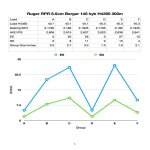Mystic Precision
CGN Ultra frequent flyer
- Location
- Summerland, BC

A very good F Open shooter and I were discussing the trend to velocity tuning. I said, bad idea... he thought, good idea. He created his own test using a superbly accurate rifle, all the steps to prepare and shoot the groups under calm conditions. Took great notes and voila, this is the data that he created.
There is a ton of info in this chart if you take the time and study it.... and it confirms what I, and many others in the LR precision game know, velocity testing can provide false positives.
ES and SD's do not tell you what will happen on target
Shoot on paper at distance. Targets don't lie. If you have 2 loads near identical, use the one with the best data... however, after almost 15yrs of launching lead way out there, I have yet to see a tie between 2 loads when tested at distance.
Accurate loads will almost always show good numbers..... good numbers in a load, does not always mean it is accurate.
Jerry








































































